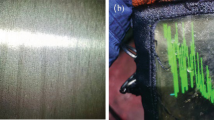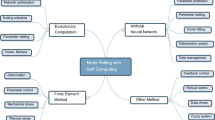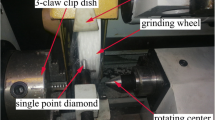Abstract
The main form of roll failure in cold rolling production is fatigue damage. To avoid industrial production accidents, the roll grinding amount after service is usually manually determined in accordance with empirical settings. This leads to excessive grinding. To address this problem, this work takes a 2130-mm UCM cold rolling production line as an example and establishes an elastic deformation model of the mill roll system based on the influence function method. The three-way stress and maximum tangential stress distribution inside the roll are calculated by means of the Hertz formula. Combined with the nonlinear fatigue accumulation model, a roll fatigue prediction model is proposed to quantitatively describe the roll fatigue state. According to the roll fatigue distribution data and actual production situation, the roll fatigue curve is shifted superimposed, and the roll grinding optimization model is established using a genetic particle swarm algorithm. It can meet the requirements of industrial production in terms of convergence speed and optimization. It applies the model to a cold rolling production line in a factory. Field application shows that the model can be used to quantify and detect roll fatigue in real time. The rolls can be dismounted at the right time, and the production accident rate from fatigue can be reduced by 33.3%. The consumption of backup rolls, intermediate rolls and work rolls can be reduced by 23.2, 24.1 and 28.6% each year, respectively. The application of this model can greatly reduce the production cost for a plant, ensure production safety and extend the service life of rolls.










Similar content being viewed by others
Availability of data and material
The authors confirm that the data and material supporting the findings of this work are available within the article.
Code availability
Not applicable.
References
T. Nodir, S. Nosir, T. Shirinkhon et al., Development of technology to increase resistance of high chromium cast iron. Am. J. Eng. Technol. 3(03), 85–92 (2021)
X. Qin, L. Xie, Q. Wu, Hardening mechanism of Cr5 backup roll material induced by rolling contact fatigue. Mater. Sci. Eng. A. 600, 195–199 (2014). https://doi.org/10.1016/j.msea.2014.01.100
R. MasoudiNejad, P. NoroozianRizi, M.S. Zoei et al., Failure analysis of a working roll under the influence of the stress field due to hot rolling process. J. Fail. Anal. Prev. 21(3), 870–879 (2021). https://doi.org/10.1007/s11668-021-01131-9
G.S. Wu, Y.T. Wang, Study on thermal fatigue performance of cold work roll steel. Appl. Mech. Mater. 117, 817–820 (2012)
X. Chen, X.L. Liu, C.H. Tao et al., Study on damage behavior and failure mechanism of rollers. Fail. Anal. Prev. 13(01), 60 (2018). https://doi.org/10.3969/j.issn.1673-6214.2018.01.011
J. Gao, G. Dai, J. Zhao, Indentation effect on the fatique limit of axle steel. J. Eng. Sci. 38(06), 827–833 (2016). https://doi.org/10.13374/j.issn2095-9389.2016.06.012
J. Hou, J. Dong, Z. Yao, Micro damage mechanism of high temperature fatigue crack growth of GH4169 alloy. J. Eng. Sci. 40(07), 822–832 (2018). https://doi.org/10.13374/j.issn2095-9389.2018.07.008
X.F. Qin, D.L. Sun, L.Y. Xie, The shakedown status and Cracks’ initiate location analysis on the contact patch of pc hot rolling mills’ backup roll. Mach. Des. Manuf. 11, 6–9 (2013). https://doi.org/10.3969/j.issn.1001-3997.2013.11.002
W. Y. Lu, Mechanical analysis of work roller’s surface stress and wear failure on cold rolling. Qinhuangdao: Yanshan University (2009). https://doi.org/10.7666/d.D621320
H.B. Li, C.Y. Xia, J. Zhang, Simulated and experimental study on attenuation process of the surface topography of cold rolling work rolls with cellular automaton. J. Mech. Eng. 56(03), 207–215 (2020)
X. Xiong, The several important problems of cold rolls in the using and maintenance technology. Sichuan Metall. 36(06), 22 (2014). https://doi.org/10.3969/j.issn.1001-5108.2014.06.006
J.H. Sun, X.Y. Shen, J.J. Yan et al., Analysis and improvement strategy for roll consumption of Si-steel. China Metall. 22(03), 18 (2012)
J.G. Cao, X.M. Meng, G.H. Yang et al., Setup model based on genetic algorithm for roll bending force of double stand UCM cold rolling mills. J. Tianjin Univ. 44(07), 650 (2011). https://doi.org/10.3969/j.issn.0493-2137.2011.07.017
M.H. Sun, Z. Xu, L.K. Zheng et al., Optimization of twin-roll thin strip vibrating casting screw-down control systems based on improved PSO algorithm. China Mech. Eng. 31(03), 360 (2020). https://doi.org/10.3969/j.issn.1004-132X.2020.03.015
Q.L. Wang, X. Li, J. Sun et al., Mathematical and numerical analysis of cross-directional control for SmartCrown rolls in strip mill. J. Manuf. Process. 69, 451–472 (2021). https://doi.org/10.1016/j.jmapro.2021.07.067
Q. Wang, J. Sun, X. Li et al., Analysis of lateral metal flow-induced flatness deviations of rolled steel strip: mathematical modelling and simulation experiments. Appl. Math. Model. 77, 289–308 (2020)
M.A. Mekicha, M.B. De Rooij, L. Jacobs et al., Experimental validation of contact models for cold-rolling processes. J. Mater. Process. Technol. 275, 116371 (2020). https://doi.org/10.1016/j.jmatprotec.2019.116371
X. Wang, Q. Yang, Z. Jiang et al., Research on the improvement effect of high tension on flatness deviation in cold strip rolling. Steel Res. Int. 85(11), 1560–1570 (2014). https://doi.org/10.1002/srin.201400048
F.J. Zuo, H.Z. Huang, S.P. Zhu et al., Fatigue life prediction under variable amplitude loading using a nonlinear damage accumulation model. Int. J. Damage Mech. 24(5), 767–784 (2015). https://doi.org/10.1177/1056789514553042
S. Kwofie, N. Rahbar, A fatigue driving stress approach to damage and life prediction under variable amplitude loading. Int. J. Damage Mech. 22(3), 393–404 (2013). https://doi.org/10.1177/1056789512449638
X. Qin, S. Dale, L. Xie et al., Subsurface rolling contact fatigue damage distribution of backup roll after periodic dressing. J. Fail. Anal. Prev. 14(4), 491–496 (2014). https://doi.org/10.1007/s11668-014-9833-3
J.W. Seo, B.C. Goo, J.B. Choi et al., Effects of metal removal and residual stress on the contact fatigue life of railway wheels. Int. J. Fatigue. 30(10–11), 2021–2029 (2008)
T.F. Wang, Grid Trust Model Based on Family Gene in Computer Genetics. (Intellectual Property Press, Beijing, 2016) https://doi.org/10.3969/j.issn.1009-3087.2006.06.025
C. Zhang, Q. Li, J.Y. Dong, Switch strategy based on chaos particle swarm optimization and specialized genetic algorithm for path planning of mobile robots. J. Beijing Univ. Sci. Technol. 35(06), 826–830 (2013)
X.H. Cui, J.L. Sun, Genetic algorithm solution of plate rolling mill FM backup roll wear model. Tianjin Metall. 04, 21 (2010). https://doi.org/10.3969/j.issn.1006-110X.2010.04.008
F. Kong, L. Tong, P. Wei, Optimal scheduling ofconverter oxygen based on particle swarm optimization. J. Eng. Sci. 43(02), 279–288 (2021)
G. Zheng, L.H. Ge, Y.Q. Shi, et al. Dynamic rolling force prediction of reversible cold rolling mill based on bp neural network with improved pso, in 2018 Chinese Automation Congress (CAC) (IEEE, 2018), pp. 2710–2714
F. Yao, W.D. Yang, M. Zhang, Improved PSO and its application to load distribution optimization of hot strip mills. J. Beijing Univ. Sci. Technol. 31(08), 1061–1066 (2009). https://doi.org/10.3321/j.issn:1001-053X.2009.08.022
M.O. Shabani, A. Mazahery, Searching for a novel optimization strategy in tensile and fatigue properties of alumina particulates reinforced aluminum matrix composite. Eng. Comput. 30(4), 559–568 (2014). https://doi.org/10.1007/s00366-012-0299-1
J.H. Fu, K. Liu, Y. Xu et al., Multiobjective optimization of turntable gear transmission based on GAPSO algorithm. J. Mech. Electr. Eng. 37(04), 420 (2020). https://doi.org/10.3969/j.issn.1001-4551.2020.04.015
Author information
Authors and Affiliations
Contributions
WS provided the simulation idea and organized the experiment; TY completed the simulation and diagram drawing; ZW finished writing and sorting out articles; AH instructed the revision of the draft; YL completed data statistics and analysis and SZ completed the application implementation.
Corresponding author
Ethics declarations
Conflict of interest
The authors declare that they have no conflict of interest.
Consent to participate
Not applicable.
Consent for publication
This work has been approved by all authors for publication.
Ethics approval
Not applicable.
Additional information
Publisher's Note
Springer Nature remains neutral with regard to jurisdictional claims in published maps and institutional affiliations.
Rights and permissions
Springer Nature or its licensor (e.g. a society or other partner) holds exclusive rights to this article under a publishing agreement with the author(s) or other rightsholder(s); author self-archiving of the accepted manuscript version of this article is solely governed by the terms of such publishing agreement and applicable law.
About this article
Cite this article
Sun, W., Yuan, T., Wu, Z. et al. Optimization Model of the Cold Rolling Roll Grinding Volume Based on Nonlinear Fatigue Accumulation Regulation. J Fail. Anal. and Preven. 23, 2131–2141 (2023). https://doi.org/10.1007/s11668-023-01767-9
Received:
Revised:
Accepted:
Published:
Issue Date:
DOI: https://doi.org/10.1007/s11668-023-01767-9




